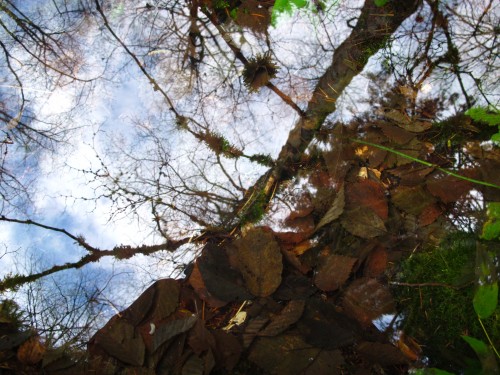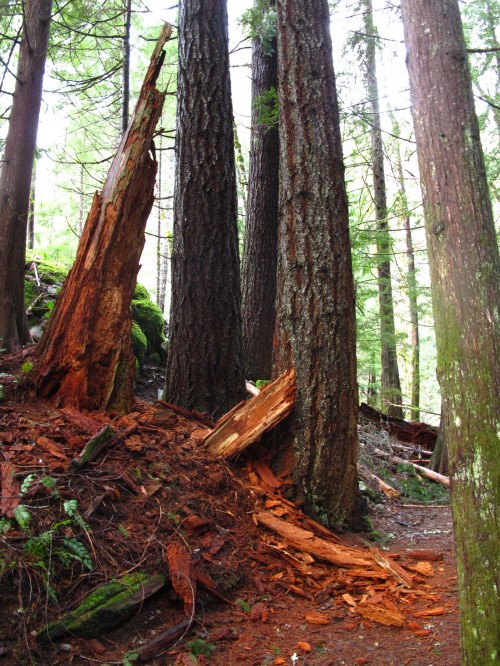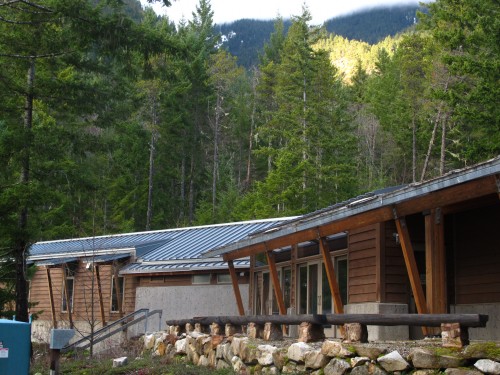A-Hunting for the Details

Today I went on a hike looking for wildflowers. I failed, miserably. But this was accounted for in the strategic plan, a given before I’d even cinched my shoelaces or threw on a daypack.
You see, it’s the middle of winter in the North Cascades. What else would one expect? But as an amateur naturalist with a penchant for all things botanical, the landscape can be a little — dare I say it? — boring. Emerald is pretty, and serves a photosynthetic purpose, and brown ground holds the nutrients to support the whole thing. But recollections of the summer’s subalpine petal-rainbow are haunting. Perhaps this admits a shallowness on my part, a doltish attraction to the obvious, a stubborn attachment to the reproductive parts and advertising wiles of plants, commonly known as flowers.
 Monkshood (Aconitum spp) and pollinator engaged in nature’s busy dance as seen on the Rainbow Lake Trail last August. This genus contains some of the most poisonous plants known to humans, containing an alkaloid that paralyzes the nerves and can fatally lower body and blood temperatures.
Monkshood (Aconitum spp) and pollinator engaged in nature’s busy dance as seen on the Rainbow Lake Trail last August. This genus contains some of the most poisonous plants known to humans, containing an alkaloid that paralyzes the nerves and can fatally lower body and blood temperatures.
Last season was hardly so harsh: the fall brought mushrooms, which, though of a different kingdom, were close enough. But this new year, even the characteristic mega-fungi have melted back from whence they sprung. Twig ID, a tradition around these parts, is just not gonna cut it; lichen and moss are fascinating, but only do it for so long. Does anyone really want to read a blog post musing on the dozen different shades of Oregon grape?
 Fall offered all sorts of intriguing decomposers, like this toasted marshmallow mass of mushroom, commonly called “bleeding tooth fungus” (Hydnellum peckii), which smelled like Juicy Fruit gum. Seriously.
Fall offered all sorts of intriguing decomposers, like this toasted marshmallow mass of mushroom, commonly called “bleeding tooth fungus” (Hydnellum peckii), which smelled like Juicy Fruit gum. Seriously.
The problem is the solution, as permaculturalists say, so what’s the remedy? Not too long ago while living in a dynamic though often ridiculous city, I grew into an expert at glimpsing the tiny things ignored by most: the swollen poppy growing solo next to a street tree near the 101 overpass, October’s spiders weaving webs in the monster trumpet vines, the aloe vera growing, appropriately, outside the tattoo shop. I needed to return to the details, big and small, of the North Cascades. I decided to stroll up the familiar trail to Sourdough’s waterfall.
It worked. An afternoon of re-kindled love, demonstrated by bounding back to the Environmental Learning Center with camera in hand, all smiles, as though returning home from a successful hunt on the savannah. Some samplings:
 Reflections on the seasonal cedar swamp near the Pi Shelter. Notice the animal signs on the trunk on the right.
Reflections on the seasonal cedar swamp near the Pi Shelter. Notice the animal signs on the trunk on the right.
 Membranous dog-lichen (Peltigera membranacea). Check out the orange apothecia, which are the fruiting bodies from the lichen’s fungal partner and will eventually release spores. Also of note, the quarter inch rhizines, which do not help in water or nutrient absorption like plant roots do, but do serve to anchor the lichen to its substrate. It’s a fascinating little world, eh?
Membranous dog-lichen (Peltigera membranacea). Check out the orange apothecia, which are the fruiting bodies from the lichen’s fungal partner and will eventually release spores. Also of note, the quarter inch rhizines, which do not help in water or nutrient absorption like plant roots do, but do serve to anchor the lichen to its substrate. It’s a fascinating little world, eh?
 Fungi on fungi! I’d been paying attention to this shelf fungi on an old snag since coming to the Environmental Learning Center in late August: It always looked and felt very solid and unchanging. Add enough rain and time, and even the toughest decomposers start to get decomposed, too.
Fungi on fungi! I’d been paying attention to this shelf fungi on an old snag since coming to the Environmental Learning Center in late August: It always looked and felt very solid and unchanging. Add enough rain and time, and even the toughest decomposers start to get decomposed, too.
 Like a sleeping sloth of the Pacific Northwest, dangling roots and dirt clods invite the imagine against a backdrop of Doug fir forest.
Like a sleeping sloth of the Pacific Northwest, dangling roots and dirt clods invite the imagine against a backdrop of Doug fir forest.
 One of several manifestations of Oregon grape (Mahonia nervosa), with a pale strand of fructose lichen caught in its spiky leaves. The primary understory species in the forest on the way to the waterfall, Mahonia provides most of the non-green hue in the wintertime forest up to the waterfall. The leaves can burst a crimson hue, spontaneously and randomly, after the plant is a couple years old.
One of several manifestations of Oregon grape (Mahonia nervosa), with a pale strand of fructose lichen caught in its spiky leaves. The primary understory species in the forest on the way to the waterfall, Mahonia provides most of the non-green hue in the wintertime forest up to the waterfall. The leaves can burst a crimson hue, spontaneously and randomly, after the plant is a couple years old.
 A miniature world of lichen and moss tumbled down with some mini-boulders from the perennial rock fall along the trail. Linger at your own risk.
A miniature world of lichen and moss tumbled down with some mini-boulders from the perennial rock fall along the trail. Linger at your own risk.
 Another animal sign? A strip of bark harvested to make a traditional Salish basket? A weather-induced injury?
Another animal sign? A strip of bark harvested to make a traditional Salish basket? A weather-induced injury?
 Yes, that is blue sky! As seen from the surface of the seasonal puddle-pond at the junction of the Sourdough Creek and East Diablo trails.
Yes, that is blue sky! As seen from the surface of the seasonal puddle-pond at the junction of the Sourdough Creek and East Diablo trails.
 Even giants disintegrate: The vermillion spire-snag of an old cedar crumbles slowly but surely onto the trail.
Even giants disintegrate: The vermillion spire-snag of an old cedar crumbles slowly but surely onto the trail.
 Evidence of flowers — hallelujah! The bright green, basal rosettes of rattlesnake plantain (Goodyera oblongifolia ) on the banks of Fawn Creek offer a rare instance of soft, living leaves in January. Come late spring, stems of small, cream-colored flowers that look like tiny orchids will grow on a tall spike emerging from the center. Early settlers believed that this plant could be used to treat rattlesnake bites because the markings on the leaves resemble that species’ scaly skin.
Evidence of flowers — hallelujah! The bright green, basal rosettes of rattlesnake plantain (Goodyera oblongifolia ) on the banks of Fawn Creek offer a rare instance of soft, living leaves in January. Come late spring, stems of small, cream-colored flowers that look like tiny orchids will grow on a tall spike emerging from the center. Early settlers believed that this plant could be used to treat rattlesnake bites because the markings on the leaves resemble that species’ scaly skin.
 A candidate for the “Brightest Organism in the Winter Forest”, witches’ butter glows like fungal gold. Note its neighbor on this alder twig, a species of avocado-green crustose lichen — a combination reminiscent of 1970’s kitchen appliances.
A candidate for the “Brightest Organism in the Winter Forest”, witches’ butter glows like fungal gold. Note its neighbor on this alder twig, a species of avocado-green crustose lichen — a combination reminiscent of 1970’s kitchen appliances.
 A small piece of Sourdough Ridge gets illuminated beyond a lodge at the Environmental Learning Center.
A small piece of Sourdough Ridge gets illuminated beyond a lodge at the Environmental Learning Center.
Leading photo: False pixie cup (Cladonia chlorophaea), a type of club lichen found on open sites, grows its upright “clubs” for reproductive purposes — notice the powdery, pale green grains (aka soredia) on the cup’s edge, awaiting to be dispersed by rain or wind. This one was found on that dry and rocky south-facing slope as one starts the immediate climb to the waterfall.
All photos by Katherine Renz
Katherine Renz is a graduate student in North Cascades Institute and Western Washington University’s M.Ed. program. This is her official call to all fellow botanizing freaks to the North Cascades this coming spring. Maybe we can start a club?

